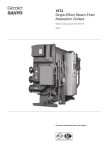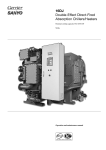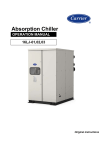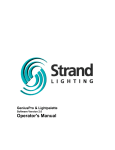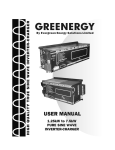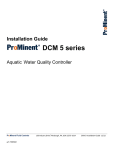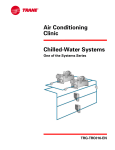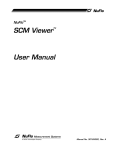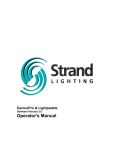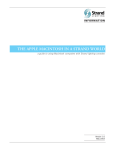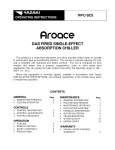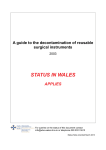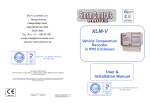Download 16NK Double-Effect Steam-Fired Absorption Chillers
Transcript
16NK Double-Effect Steam-Fired Absorption Chillers Nominal cooling capacity 345-4652 kW 50 Hz Operation and maintenance instructions GB/T-19001-2000 to ISO9001/2000 Notes to Users Thank you for purchasing a Carrier/Sanyo absorption chiller. Read this manual carefully before operating the unit. It contains instructions for the operation and maintenance of the chiller. Please utilize the chiller to its optimum performance by carrying out the recommended daily maintenance and handling instructions as well as the periodic service. If you need any information about maintenance contracts or have any other enquiries, please contact your Carrier service agent. Contents Notes to Users............................................................................................................................................................................ 2 1 - Precautions........................................................................................................................................................................... 4 1.1 - Safety precautions........................................................................................................................................................................ 4 1.2 - High-temperature - high-voltage caution.................................................................................................................................... 8 1.3 - Environmental requirements........................................................................................................................................................ 8 1.4 - Water treatment............................................................................................................................................................................ 8 2 - MACHINE IllustrationS................................................................................................................................................... 8 2.1 - Typical chiller views - all sides.................................................................................................................................................... 8 2.2 - Typical control panel................................................................................................................................................................. 12 2.3 - Chiller flowchart and component function description............................................................................................................. 14 3 - Operating instructions............................................................................................................................................... 17 3.1 - Self-diagnostic function............................................................................................................................................................. 17 3.2 - Description of keys and their functions..................................................................................................................................... 18 3.3 - Control board settings................................................................................................................................................................ 19 3.4 - Cooling operation...................................................................................................................................................................... 21 3.5 - Changing the information on the data display........................................................................................................................... 22 3.6 - Changing display and setpoint................................................................................................................................................... 23 3.7 - Maintenance message................................................................................................................................................................ 23 3.8 - Alarm messages and actions required........................................................................................................................................ 23 4 - Maintenance........................................................................................................................................................................ 25 4.1 - Daily maintenance..................................................................................................................................................................... 25 4.2 - Periodic maintenance................................................................................................................................................................. 28 4.3 - Recommended maintenance and main component replacement schedule................................................................................ 29 4.4 - Water treatment.......................................................................................................................................................................... 30 5 - Troubleshooting............................................................................................................................................................. 32 6 - Instructions........................................................................................................................................................................ 34 6.1 - Absorbent sampling method...................................................................................................................................................... 34 6.2 - Concentration measurement method......................................................................................................................................... 34 7 - Maintenance contract................................................................................................................................................ 36 7.1 - Annual maintenance contract..................................................................................................................................................... 36 7.2 - Inspection report........................................................................................................................................................................ 36 7.3 - Warranty..................................................................................................................................................................................... 36 Appendix 1 - Troubleshooting FLOWCHART............................................................................................................ 37 Problem 1 - Chiller does not run........................................................................................................................................................ 37 Problem 2 - Chilled-water temperature is high.................................................................................................................................. 38 Problem 3 - Generator alarm.............................................................................................................................................................. 39 Problem 4 - Combustion alarm (16DJ only)...................................................................................................................................... 40 Problem 5 - Water alarm.................................................................................................................................................................... 41 Problem 6 - Motor alarm.................................................................................................................................................................... 41 Problem 7 - System alarm.................................................................................................................................................................. 42 The cover photograph is for illustrative purposes only, and are not contractually binding. 1 - Precautions 1.1 - Safety precautions • • Before operating this chiller, first carefully read the following instructions. All precautions are classified as either WARNING or CAUTION. WARNING: Failure to observe this instruction may result in serious injury or death. 1.1.4.1 Safety considerations WARNINGS TURN OFF THE BREAKER BEFORE CLEANING AND CHECKING Always turn off the circuit breaker before cleaning and checking the cooling tower fan, chilled water pump, or other components linked to the chiller, to provide protection from electric shock or or possible injury by the rotating fan. INSPECTION CAUTION : Failure to observe this instruction may cause an injury or failure of chiller. Depending on circumstances, this may result in serious injury or death. This symbol denotes danger, a warning or a caution. The illustration in this symbol shows the specific description of the item. • This symbol prohibits an action. The illustration next to this symbol shows the specific description of the item. This symbol instructs an action to be done. The illustration in this symbol shows the specific description of the item. STOP OPERATION IN CASE OF FIRE, EARTHQUAKE OR ELECTRICAL STORMS Stop operation in case of fire, earthquake or an electrical storm, to prevent fire or electric shock. Must be observed After reading this manual, it should be kept in a safe place to be available for any user at any time. DO NOT TOUCH THE CONTROL PANEL SWITCH WITH WET HANDS Do not touch the switch inside the control panel with wet hands to avoid electric shock. SWITCH Do not touch DO NOT TOUCH THE WIRING INSIDE THE CONTROL PANEL Do not touch the wiring inside the control panel to avoid electric shock. Do not touch WARNINGS DO NOT TOUCH ROTATING MOTOR PARTS Keep away from rotating parts of motors or pumps to avoid possible injury. Prohibited VENTILATE THE MACHINE ROOM Ventilate the machine room while nitrogen gas is discharged to avoid anoxia. CAUTIONS SOLVE ALL PROBLEMS BEFORE RESTARTING THE CHILLER Solve all the problems before restarting the chiller after a safety or security device is activated. Must be observed DO NOT PLACE HEAVY OBJECTS ON THE CHILLER OR CONTROL PANEL Do not place heavy objects on the chiller or control panel as these may fall off and cause injuries. Prohibited Must be OPERATed DO NOT CLIMB ON THE CHILLER Do not climb on the chiller as you may fall off. Prohibited AUTHORIZED PERSONNEL ONLY A notice, "For Authorized Personnel Only" must be affixed to the chiller to stop unauthorized personnel from touching it. If necessary surround the chiller by a protective fence. Misuse of the chiller may cause injury. Prohibited DO NOT POUR WATER ON THE CHILLER OR CONTROL PANEL Do not pour water on the chiller or control panel to avoid electric shock. Prohibited DO NOT TOUCH HIGH-TEMPERATURE AREAS Do not touch high-temperature areas, as they may cause burns. These areas are indicated by caution label. CAUTIONS USE THE CORRECT POWER SUPPLY This is indicated on the chiller name plate. Use of an incorrect power supply may cause fire or electric shock. Prohibited Prohibited What voltage? STOP THE PURGE PUMP TO REPLACE OIL Stop the purge pump when replacing oil to avoid possible injury by fuel spillage. NEVER CHANGE THE SET VALUES Never change the set values of the safety and/or protective devices. Wrong settings may damage the chiller or cause fire. Prohibited DO NOT TOUCH THE ABSORBENT Do not touch spare or leaked absorbent, as this can cause metal corrosion or skin disease. Prohibited OBSERVE THE SPECIFIED WATER/STEAM PRESSURE The specified chilled water, cooling water and steam pressure must be strictly observed. Incorrect pressure may cause the water to leak/spray which can lead to short circuits or burns. Must be observed STOP Must be observed 1.1.2 - Safety precautions for repair, moving or disposal WARNINGS ONLY AUTHORIZED PERSONNEL SHOULD SERVICE THE CHILLER Only authorized personnel should service the chiller. Incorrect service could result in electric shock or fire. Prohibited 1.1.3 - Operating precautions 1. Keep the purge valve tightly shut to prevent air from leaking into the chiller, which may cause the failure of the chiller. 2. Keep the power supply to the control panel turned on, unless carrying out maintenance or service. 3. During the chiller dilution cycle the chilled-water pump (both the primary side and the secondary side) and air handling unit must be operated for the required time. The chiller has some cooling capacity, even in the dilution cycle. Do not stop the air handling unit before the required time to prevent possible subcooling. 4. Do not perform an insulation test on the control circuits of the electric controller. 5 . Use a Carrier recommended interlock system to stop/start the auxiliary equipment. The interlock system automatically stops/starts the chilled-water pump and cooling water pump. Follow the start procedure in Figure 1 below. CAUTIONS ONLY AUTHORIZED PERSONNEL SHOULD REMOVE OR REPAIR THE CHILLER Any relocation or moving of the chiller should only be done by authorized personnel. Incorrect work could result in water leaks, electric shock or fire. Fig. 1 - Auxiliary equipment start/stop sequence Start sequence 1: Chilled water pump 2: Cooling water pump 3: Cooling tower 4: Absorption chiller 5: Air handling unit Must be observed Stop sequence 1 Absorption chiller ONLY AUTHORIZED PERSONNEL SHOULD DISPOSE OF THE CHILLER To dispose of the chiller, contact local specialists. Incorrect disposal may result in absorbent leaks and cause metal corrosion or skin disease, electric shock or fire. 2: Cooling water pump 3: Cooling tower 4: Chilled water pump 5: Air handling unit Must be observed 1.2 - High-temperature - high-voltage caution 2 - MACHINE IllustrationS • 2.1 - Typical chiller views - all sides • • • Do not touch the chiller during operation since its surface becomes hot. Do not touch the absorbent pump, the refrigerant pump, and the purge pump during operation, since their surface becomes hot. Do not touch the junction box during operation, since it contains high-voltage wiring. Do not touch the terminal box during operation, since it contains high-voltage wiring. 2.1.1 - 16NK 11 to 63 Fig. 2 - Water header side 6 1 1.3 - Environmental requirements 1.3.1 - Installation considerations The 16NK absorption chiller is designed for indoor installation in a machine room. The protection rating of the chiller is IP40. Room temperature should be maintained between 5°C and 40°C to protect against solution crystallization during chiller shutdown. The humidity in the machine room must be kept below 90%. 1.3.2 - Field wiring The machines should be connected to a power source that complies with overvoltage category III (IEC 60664). All other wiring should comply with overvoltage category II. 1.3.3 - Altitude Please install the absorption chiller at a maximum height of 1000 m above sea level. If the location is higher than 1000 m above sea level, please contact your local Carrier office. 1.4 - Water treatment 7 8 2 9 3 4 5 Legend 1 Condenser 2 Chilled water outlet 3 Chilled water inlet 4 Evaporator 5 Cooling water inlet 6 Low-temperature generator 7 High temperature generator 8 Steam inlet 9 Absorber Fig. 3 - Water header side (rear) Refer to chapter 4 "Maintenance”. 2 1 6 3 7 4 5 Legend 1 High-temperature generator 2 Low-temperature generator 3 Cooling water outlet 4 Evaporator 5 Steam trap 6 Condenser 7 Absorber Fig. 4 - Control panel side (evaporator side) 1 2 6 5 4 3 Legend 1 Control panel 2 Purge tank 3Refrigerant drain heat reclaimer 4 Absorbent pump 1 5Refrigerant pump 6Refrigerant blow valve Fig. 5 - High-temperature generator side (absorber side) 1 3 2 4 5 6 7 8 Legend 1 Purge unit 2 High-temperature heat reclaimer 3 Purge pump 4 Low-temperature heat exchanger 5 Low-temperature heat reclaimer 6 Steam drain outlet 7 High-temperature heat exchanger 8 Absorbent pump 2 2.1.2 - 16NK 71 to 81 Fig. 6 - Water header side 2 3 Fig. 7 - Water header side (rear) 1 2 1 4 7 4 8 9 3 10 5 5 6 6 Legend 1 Low-temperature generator 2 High-temperature generator 3 Steam drain outlet 4 Condenser 5 Absorber 6 Evaporator 7 Absorber Legend 1 Steam inlet/high-temperature generator 2 Low-temperature generator 3 Cooling water outlet 4 Chilled water outlet 5 Chilled water inlet 6 Cooling water inlet 7 Condenser 8 Absorber 9 Evaporator 10 Absorber Fig. 8 - Control panel side 1 8 Legend 1 Control panel 2Refrigerant blow valve 3 Purge tank 4 Purge unit 5 Purge pump 6Refrigerant drain heat exchanger 7Refrigerant pump 8 Low-temperature heat exchanger 10 2 3 7 6 4 5 7 Fig. 9 - High-temperature heat reclaimer side 1 6 5 4 3 2 Legend 1 High-temperature heat reclaimer 2 Absorbent pump 2 3 Low-temperature heat exchanger 4 Absorbent pump 1 5Refrigerant pump 6 High-temperature heat exchanger 11 2.2 - Typical control panel Fig. 10 - Control panel (CE type) Fig. 11 - Control panel inside (CE type) 1 1 13 6 2 2 3 4 5 7 8 6 9 7 8 9 3 10 10 4 11 5 Legend 1 Fan 2Terminal block 3Terminal block 4Terminal block for power supply 5 Earth terminal 6 Control board 7 Purge indication light 8 Alarm buzzer 9 Purge pump on/off switcht 10Operating handle 12 12 Legend 1 Control relay 2 Circuit protector 3 Isolator 4 I/O board 5 AC reactor 6 Circuit breaker 7 Inverter 8 DC reactor 9 Main circuit breaker 10Transformer 11 Electromagnetic contactor 12 Filter 13Transformer 14Terminal block 14 Fig. 12 - Control board 1 2 3 4 StoP 5 rUN CHILLEr 6 #1 AbS PUMP #2 AbS PUMP rEF PUMP SEt bACK PUrGE PUMP 7 rEMotE 8 StAND bY DILUtIoN SAFEtY CIrCUIt CHILLEr ALArM bUZZEr StoP StoP LoCAL oPErAtIoN 9 rUN PoWEr 10 11 12 13 14 Legend 1 Stop indication light 2Operation indication light 3 Data display 4 Select key 5 Function set key 6Back select key 7Remote/local select key with LED 8 Alarm buzzer stop key 9Operation select key with LED 10 Alarm indication light 11 Stand-by indication light 12 Dilution indication light 13 Safety circuit indication light 14 Power indication light 13 2.3 - Chiller flowchart and component function description Evaporator The refrigerant is dispersed on the heat transfer tubes of the evaporator. Chilled water running through the heat transfer tubes of evaporator is cooled by the latent heat of vaporized refrigerant. Absorber The concentrated solution is dispersed on the heat transfer tubes of absorber. The refrigerant vapour from the evaporator is absorbed on the heat transfer tubes of the absorber by the concentrated solution. Cooling water running through the heat transfer tubes of the absorber is heated by the absorption heat. Solution heat exchangers In order to increase the efficiency of the chiller, two solution heat exchangers are provided. One is a low-temperature heat exchanger and the other is a high-temperature heat exchanger. In the low-temperature heat exchanger, heat exchange takes place between the concentrated solution and the diluted solution. In the high-temperature heat exchanger, heat exchange takes place between the intermediate solution and the diluted solution. High-temperature generator The diluted solution from the high-temperature heat exchanger is heated and releases refrigerant vapour. It then changes to the intermediate solution. Low-temperature generator The refrigerant vapour from the high-temperature generator passes through the heat transfer tubes of the low-temperature generator. The intermediate solution in the low-temperature generator is heated by the refrigerant vapour. It releases refrigerant vapour and is concentrated. It changes to the concentrated solution. The condensed refrigerant in the heat transfer tubes of the low-temperature generator flows to the condenser. Condenser The refrigerant vapour from the generator is condensed on the heat transfer tubes of the condenser. Cooling water from the absorber is heated by condensation heat. Purge unit The purge unit collects the non-condensable gas in the chiller and stores it in the purge tank. Refrigerant drain heat reclaimer This heat exchanger is provided in order to increase the efficiency of the chiller. In this heat reclaimer heat exchange takes place between the diluted solution and the condensed refrigerant from the low-temperature generator. High and low-temperature heat reclaimers These heat reclaimers are provided in order to recover heat from the steam drain, In these heat reclaimers heat exchange takes place between the diluted solution and the steam drain. 14 Sensors Symbol DT1 DT3 DT4 DT5 DT6 DT7 DT8 DT9 DT11 DT12 DT13 E1-3 63CH 69CH 69PR Name Chilled-water leaving temperature High-temperature generator temperature Low-temperature generator temperature Condenser temperature Chilled-water entering temperature Cooling water entering temperature Cooling water intermediate temperature Cooling water leaving temperature Evaporator refrigerant temperature Diluted solution temperature sensor at absorber outlet Steam drain temperature High-temperature generator solution level electrode High-temperature generator pressure switch Chilled water flow switch Purge tank pressure switch Fig. 13 - Flow diagram 12 13 25 26 6 27 11 V2 7 2 14 V3 3 22 4 SV1 15 V1 23 21 24 20 5 1 17 8 9 10 16 18 19 Fig. 14 - Flow diagram 12 13 26 25 6 27 11 7 2 14 3 22 4 15 23 21 24 20 5 1 8 9 10 17 16 19 Sensor Service valve Strainer Damper Check valve Orifice Valve 15 Legend for Figs. 13 and 14 1 Purge pump 2B-valve 3 Chilled water outlet 4 Chilled water inlet 5 Purge unit 6 Cooling water outlet 7 Purge tank 8Refrigerant pump 9Refrigerant blow valve 10 Absorbent pump 1 11Rupture disk 12 Condenser 13 Low-temperature generator 14 Evaporator 15 Absorber 16 Cooling water inlet 17 Low-temperature heat exchanger 18 Low-temperature heat reclaimer 19 Steam drain outlet 20Refrigerant drain heat reclaimer 21 Absorbent pump 2 22 High-temperature heat exchanger 23 Steam trap 24 High-temperature heat reclaimer 25 High-temperature generator 26 Steam inlet 27 Steam control valve 16 D1 Diluted solution main damper D2 Diluted solution low temperature heat exchanger damper D3 Diluted solution refrigerant drain heat reclaimer damper D4 Intermediate solution damper D5 Concentrated solution damper D6Refrigerant drain damper D7Refrigerant recycling damper D8 Diluted solution bypass damper V1 Manual purge valve V2 Manual purge valve V3 Manual purge valve SV1 Charge/discharge N2 gas and pressure gauge installation service valve SV3Refrigerant service valve SV4 Diluted solution service valve SV5 Intermediate solution service valve SV6 Concentrated solution service valve SV7 Generator maintenance service valve SV8 Generator maintenance service valve B valve Manual purge valve 3 - Operating instructions 3.1 - Self-diagnostic function The self-diagnostic function starts when the breaker inside the control panel of the chiller is turned on. After self-diagnosis is completed, the data display on the control board shows the following information. • • Data display (7-segment LED) and all LEDs light up. If there is no abnormality the data display shows the version number. If there is a power failure, H-10 is displayed after the power is restored. Fig. 15 - Control panel Note: The version number differs with each chiller type. • The data display shows the generator temperature. (120.4) If the self-diagnosis function detects an error, this will be shown on the data display. For the alarm indication, please refer to chapter 3.8. 17 3.2 - Description of keys and their functions Fig. 16 - Typical control board 6 1 2 StoP 11 rUN CHILLEr #1 AbS PUMP #2 AbS PUMP rEF PUMP 7 8 9 12 rEMotE 4 StAND bY DILUtIoN SAFEtY CIrCUIt 10 bACK SEt PUrGE PUMP CHILLEr ALArM PoWEr bUZZEr StoP StoP LoCAL oPErAtIoN rUN 5 3 Legend 1Operation indication light:The operation indication light is on when the chiller is running. 2 Stop indication light:The stop indication light is on when the chiller is shut down. 3 Alarm indication light:The alarm indication light is on when an alarm occurs. 4Remote/local select key with LED:To select remote operation or local operation. 5Operation select key with LED: Key used to run/stop the chiller. The stop key is also used for alarm reset. 6 Data display (7-segment LED): Shows the temperature, setpoint, etc. 7 Standby indication light:On when the chiller is waiting for the interlock signals form the chilled water and the cooling water pump. 8 Dilution indication light:On during the dilution cycle. 9 Safety circuit indication light:On when power is supplied to the control circuit. 10 Power indication light:On when power is supplied to the control circuit. 11 Data select key:To change the menu and set a new value. 12 Alarm buzzer stop key:To stop the alarm buzzer. 18 3.3 - Control board settings Fig. 17 - Display example (cont.) 3.3.1 -Time setting Refer to Figure 17. Fig. 17 - Display example Generator temperature Press the " SET " key for about 2 seconds. Press s key to set the day. Press the SET key for about 2 seconds. Press t key. Press t key. Press the " SET " key for about 2 seconds. Press the SET key for about 2 seconds. Press the " SET " key for about 2 seconds. Press s key to set the hour. Press t or s key. Press t key. Press the " SET " key for about 2 seconds. Press s key to set the minutes. Press t key. Press the SET key for about 2 seconds. Press the SET key for about 2 seconds. Press the BACK key. Press s key to set the month. Press the BACK key. Press t key. Generator temperature 3.3.2 - Battery backup Refer to Figure 18. SW3 Connect a backup battery which is used to maintain the time setting when a power failure occurs. Turn it ON after installing the equipment. CR-2025 is used as the backup battery and has an accumulative operating period of about six months. NoteS: 1. SW3 (battery backup) is set to OFF at the factory to avoid using battery power. 2. If SW3 (battery backup) is set to OFF when a power failure occurs, F-21 (CPU alarm) or F-23 (Time set alarm) is displayed. Please reset the time setting. 3. If SW3 (battery backup) is set to ON and F-21 or F-23 is displayed, it is necessary to replace the battery. 19 20 LABEL SW3:Backup switch UP:ON DOWN:OFF Backup battery Fig. 18- SW3 backup switch and backup battery 3.3.3 - How to change the temperature unit The temperature unit can be changed as follows, even while the chiller is operating. Fig. 19 - Display example Press the " SET " key for about 2 seconds. Generator temperature Press t or s key. Press the SET key for about 2 seconds. Press t or s key if you need. Press the SET key for about 2 seconds. And push t or s key. To select °C To select °F 3.4 - Cooling operation 3.4.1 - Pre-operation checks Please check the following items before starting operation: • Check the setpoint of the chilled-water leaving temperature. Make sure that the chilled-water leaving temperature is set as specified. For the indication of the set value, please refer to chapter 3.8. • Check the steam and steam drain equipment - Make a daily inspection (refer to chapter 4). - Check that the steam valve(s) is (are) open. NOTE: To start and stop the chilled water pump and cooling water pump, always use the start and stop signal from the chiller control panel. Strictly ensure that the interlock signals from the chilled water pump and the cooling water pump are connected to the chiller control panel. 3.4.2 - Start of operation Refer to Figure 21. Fig. 21 - Control board Press the "SET" key to select °C mode and again to select the °F mode 3.3.4 - Changing remote signal setting (continuous, pulse etc.) After wiring of the remote signal, the control board shown below should be set. Refer to field wiring diagram. Fig. 20 - Display example Control board setting Remote signal type (1) (2) (3) (4) (5) free StoP rUN CHILLEr free #1 AbS PUMP #2 AbS PUMP rEF PUMP Generator temperature Press the SET key for about 2 seconds. SEt bACK PUrGE PUMP 1 rEMotE Press the t or s key. 2 StAND bY DILUtIoN bUZZEr StoP SAFEtY CIrCUIt Press the SET key for about 2 seconds. CHILLEr ALArM PoWEr Press the t or s key. Press the t or s key. To select the static mode By pressing the SET key, the static mode is selected. Press the SET key for about 2 seconds. Then press the t or s key. Press SET key to select positive mode. 3 oPErAtIoN rUN 4 Legend 1Remote key 2 Local key 3 Stop key 4Run key To select the pulse mode By pressing the SET key, the pulse mode is selected. Press the SET key for about 2 seconds. Then press the t or s key. To select the positive mode StoP LoCAL To select the negative mode Press SET" key to select negative mode. Local operation mode • Press the "LOCAL" key on the chiller control board. The "LOCAL" indication light of the key is on. • Keep pressing the "RUN" key for more than a second and make sure that the "RUN" indicator lightp of the key is on. • Automatic operation starts. Remote operation mode • Press the "REMOTE" key on the chiller control board. The "REMOTE" indicaton light of the key is on. 21 • • Turn on the start switch on the remote control panel for the field supply. The indicator light of the "RUN" key on the chiller control board is on. Automatic operation starts. 3.5.1 - Normal display information The data display on the control board usually shows the generator temperature as follows. It returns to the generator temperature display when no key is pressed for 1 minute. NOTE: In local operation mode the signal from the remote control panel does not work. In remote operation mode the "RUN" key of the chiller control board does not work. 3.5.2 - Changing the display Refer to Figure 22. 3.4.3 - Stop of operation Refer to Figure 21. Local operation mode • Keep pressing the "STOP" key on the chiller control board for more than a second. • Make sure that the "RUN" indication light goes off and the "STOP" indication light comes on. Remote operation mode • Turn on the stop switch on the field supply remote control panel. • Another way to stop the chiller is to press the "STOP" key on the chiller control board during remote operation. NOTE: Since the chilled-water pump, cooling water pump, and chiller are interlocked, each pump stops automatically when the chiller stops. The air handling unit must be stopped after the chilled-water pump is stopped If you press the s key, the information on data display changes in the correct order, and pressing the t key, it changes in reverse order. If you press the s key again when the last information is shown, the display returns to the normal display information. 3.5.3 - Typical display order Real-time data is shown in the data display (7-segment LED and 6 figures). The display shows a data code (content distinction by code number) and various operating times, on/off time, component temperatures, chilled-water temperature setpoints and alarm codes. A data code is sent in turn from the s t keys and displayed. An alarm code is only shown when one or several abnormalities occur. The alarm code is shown in order of importance, and a dotted "." is shown under the number to the right of the alarm code. When several faults occur, use the s t keys to display the additional alarm codes. If no key including the "BACK" key is pressed for 1 minute, the display returns to the generator temperature display. Fig. 23 - Typical display order 3.5 - Changing the information on the data display #1 AbS PUMP Data code Data name Display - Generator temperature 1. Chiller operating hours 2. Absorbent pump 1 operating hours 3. Absorbent pump 2 operating hours 4. Combustion hours 5.Refrigerant pump operating hours 6. Purge pump operating hours 7. Chiller on/off times 8. Absorbent pump 1 on/off times 9. Absorbent pump 2 on/off times A. Combustion on/off times B.Refrigerant pump on/off times C. Purge pump on/off times 10. Chilled-water temperature setpoint 11. Hot-water temperature setpoint* 12. Chilled-water entering temperature 13. Chilled-water leaving temperature 14. Cooling water entering temperature 15. Condenser temperature 16. Steam drain/exhaust gas temperature 17. Purge tank pressure - Generator temperature #2 AbS PUMP * Hot-water reference is not applicable to 16NK units Fig. 22 - Control board 1 2 StoP rUN CHILLEr rEF PUMP SEt bACK PUrGE PUMP rEMotE StAND bY DILUtIoN SAFEtY CIrCUIt CHILLEr ALArM bUZZEr StoP StoP PoWEr Legend 1 Data display 2 Select key: changes the data display information 3Back select key 22 LoCAL oPErAtIoN rUN 3 Means 135.0°C 1234 hours 1111 hours 1230 hours Not used 1201 hours 107 hours 123 times 169 times 123 times Not used 138 times 51 times 7.0°C Not used 11.9°C 6.8°C 31.8°C 34.7°C 211.7°C 8.5 kPa 135.0°C 3.6 - Changing display and setpoint Setpoint display change Select the current setpoint temperature and change it as follows. To change the chilled-water temperature: 7.0°C Press the SET key for about 2 seconds. A number showing the setpoint temperature blinks. Press the s or t key. Fig. 24 - Maintenance message Data code Data name Display Means H-01*Operate purge pumpOperate purge pump. H-03* Clean cooling water tubes Fouling of cooling water tubes. H-04* Check cooling water system Check cooling water pump, cooling tower, etc. H-06** Purge tank high pressure Purge tank pressure is high. H-07** Cooling water tubes foul Fouling of cooling water tubes. H-08** Cooling water high temperature Cooling water temperature is high. H-10 Power failureThere was a power failure while the chiller was operating Legend * When this appears, immediate action is required. ** When this appears, no immediate action is required, but as this might lead to a higher code, attention should be paid. Consult Carrier service personnel at the next periodic maintenance. Note: These displays disappear when the problem has been corrected. Fig. 25 - Maintenance message descriptions and actions required Maintenance message Display Maintenance Message DisplayAction 1 Fouling cooling water of tubes 1 Cooling water tubes foul 7.5°C Press the SET key Action Cooling water tubes must be cleaned. Cooling water tubes must be cleaned. Contact Carrier service agent to do the job Contact Carrier/SANYo service agent to do the job. 2 Vacuum rate 2 Vacuum rateThe purge tank must be purged immediately. the purge tank must is beshown purged immediately. If this message frequently, contact In case this indication is shown frequently, your Carrier service agent. contact Carrier/SANYo service agent. 3 Cooling water 3 High temperature high temperature Check the cooling water pump, cooling tower, etc. of cooling water Check the cooling water pump, cooling tower, etc. Power failure 4 Power4 failure See section 3-8-5. See section 3.8.5. 3.8 - Alarm messages and actions required The setpoint change has been made. If no key including the "BACK" key is pressed for 1 minute, the display returns to the generator temperature. NOTES: 1. Incorrect setting may cause chiller failure. If you need to change the setpoint, always consult your Carrier service agent. 2. Setpoints become effective as soon as they have been changed. Be careful when changing setpoints during operation. 3.7 - Maintenance message If a problem that could affect the efficient operation of the chiller is predicted, a warning message is given. This includes a comment on the data display as shown in Figure 18. 3.8.1 - How they are shown When an alarm is detected, the alarm buzzer sounds, and the alarm message is shown on the data display. At the same time, the indication light of the "STOP" key blinks. The chiller stops for safety reasons after the dilution cycle. Depending on the alarm message it may also stop without carrying out the dilution cycle. Fig. 26 - Display example Chilled-water low temperature An alarm code is only shown when one or several abnormalities occur. If several errors have occurred, the most important one is shown with a dot ".". Chilled-water low temperature The other alarm codes are shown by pressing the s key. The high-temperature generator solution level is too low. 23 3.8.2 - Troubleshooting flowchart 3.8.4 - Locating and clearing alarm Fig. 28 - List of alarm messages and their causes and remedies SymptomsAction An alarm occurs. Display and content of alarm Alarm of the chilled water and/or cooling water system Check that the discharge pressure of both chillledChilled water temperature is too low. water and cooling water pumps is normal. Alarm buzzer sounds, and the indication light of the "STOP" key blinks. The alarm message is shown in the data display. Press the "BUZZER STOP" key on the control board. Chilled water flow alarm Cooling water temperature is too low Cooling water flow alarm (option) The alarm buzzer stops. Check alarm message and solve the problem. Press the "STOP" key on the control board after the troubleshooting is completed. The indication light of the "STOP" key stops blinking and remains lit. The alarm code on the data display disappears. Note: If the data display still shows an alarm, after the "STOP" key has been pressed, ensure that the alarm cause has definitely been removed. Start operation Operation restarts. 3.8.3 - Alarm message and setpoint Fig. 27 - List of alarms and setpoints in cooling operation Purpose Protection of chilled water system from freezing Display Alarm message Chilled water pump interlocl alarm Prevention of Crystallisation and Generator protection Motor protection 24 Setpoint Chilled water temperature is too low 2.5°C or below - Chilled water flow alarm 50% or below Cooling water temperature is too low Below monitoring temperature for 30 minutes Cooling water pump interlock alarm - Cooling water flow alarm (option) 50 % or below Generator temperature is too high 162°C or higher for 10 minutes 165°C or higher immediately Generator pressure is too high 0 MPa or above High concentration of absorbent 65% twice 65.5% Immediately Absorbent pump 1 overload alarm Rated current value or above Absorbent pump 2 overload alarm Rated current value or above Refrigerant pump overload alarm Rated current value or above Purge pump overload alarm Rated current value or above Alarm of the motor(s) Absorbent pump 1 overload alarm. Absorbent pump 2 overload alarm. Refrigerant pump overload alarm →If not, the strainer may be clogged, or there may be an air leak in the piping, etc. Is the chilled-water setpoint too low? →Correct it to the specified setpoint. Is the cooling water setpoint too low? →Correct it to specified setpoint (e.g. 28°C). Correct the above causes and restart the chiller. If the "CHILLER ALARM" continues, check the following and contact your Carrier service agent: • Entering and leaving chilled-water temperature • Entering and leaving cooling water temperature • Generator temperature and pressure First check that the reset button(s) of the overload relay connected to the electromagnetic contactor is not pushed in, and then contact your Carrier service agent. Reset buttons Alarm of the auxiliary equipment Chilled water pump interlock alarm. Cooling water pump interlock alarm. Check that the chilled-water pump and cooling water pump are rotating. →Start the pumps Check the fan and/or other equipment connected to the system interlock. Correct the above causes and restart the chiller. If the "CHILLER ALARM" continues, contact your Carrier service agent. Generator alarm Generator temperature is too high. Generator pressure is too high. Check that the cooling water pump is rotating. → Start the pump. Check that the cooling water line valve is open. →Open the valve. Check that the cooling water pump discharge pressure is normal. →If not, the strainer may be clogged, or there may be an air leak in the piping, etc. High concentration of absorbent Correct the above causes and restart the chiller If the "CHILLER ALARM" continues, check the following and contact your Carrier service agent: • Entering and leaving chilled-water temperature • Entering and leaving cooling water temperature • Generator temperature and pressure. • Is the chilled water setpoint too low? →Correct it to the specified setpoint. • Water in the heat transfer tubes may be fouled (especially cooling water). Sensor alarm Is the sensor short-circuited? Entering chilled-water temperature →Check all chiller sensors and contact your sensor alarm. Carrier service agent. Entering cooling water temperature sensor alarm. Leaving cooling water temperature sensor alarm. Cooling water intermediate temperature sensor alarm. Condenser temperature sensor alarm. Low-temperature generator temperature sensor alarm. Refrigerant temperature sensor alarm (evaporator). Diluted solution temperature sensor alarm (absorber outlet). Leaving chilled-water temperature sensor alarm. Generator temperature sensor alarm. Steam drain temperature sensor failure Purge tank pressure sensor alarm. NOTE: The chiller automatically stops for safety reasons when either the generator temperature or the chilled-water temperature sensor has an alarm. It does not stop when other sensors have an alarm, but this could cause control failure. Please contact your Carrier service agent as soon as possible. 3.8.5 - Action in case of a power failure Flowchart of actions in case of a power failure Power failure occurs. The chiller stops completely. Power returns. Actions to be taken if a power failure occurs If a power failure occurs, the chiller stops completely without carrying out a dilution cycle. Special attention should be paid to the following. Actions required when a power failure occurs Operation condition at power failureAction Occurred during cooling operation, and power did not return for over an hour Immediately contact your Carrier service agent. Do not restart operation. Occurred during cooling operation, and power returned in less than an hour Contact Carrier service agent after restarting operation. Occurred during purging operation Immediately close the purge valve completely and turn the purge pump switch on the control panel off. After the power is restored, restart purging, and consult your Carrier service agent. 4 - Maintenance 4.1 - Daily maintenance 4.1.1 - Inspection of each chiller component If you find an abnormal condition, contact your Carrier service agent: • Oil leak around the chiller • Abnormal noise of absorbent pump and refrigerant pump For the following items please consult the system manufacturer: • Cleaning of cooling tower and cooling water line strainer • Check the condition of the cooling tower • Check for air leaks in the piping 4.1.2 - Operation data record Please record the operation data regularly, as this is useful for troubleshooting and alarm prevention. Show the record to the Carrier service personnel when they visit you for the service or the periodic inspection. On the next page you will find a sample of the operation data sheet. Power failure alarm H-10 is shown on the data display. Press the "RUN" key. Operation restarts. Power failure alarm on the data display disappears. 25 TEST OPERATION DATA SHEET Trial run data sheet Project name chiller model Serial number Accepted by Reviewed by Recorded by 1/2 : _ ________________________________________ : 16NK-____________________________________ : _ ________________________________________ : _ ___________________________ Date_ __________________________ : _ ___________________________ Date_ __________________________ : _ ___________________________ Date_ __________________________ Unit model/serial No. No. Data items 1 2 3 4 5 6 7 8 9 10 11 12 13 14 15 16 17 18 19 20 21 22 23 24 25 26 27 28 29 30 31 32 26 Ambient temperature Room temperature Chilled-water entering temperature Chilled-water leaving temperature Chilled-water entering pressure Chilled-water leaving pressure Evaporator pressure drop Chilled water flow rate Cooling capacity Operator: Unit °C/°F °C/°F °C/°F °C/°F kPa/psi kPa/psi kPa/psi l/s/gpm kW USRT Cooling water entering temperature °C/°F Cooling water leaving temperature °C/°F Cooling water entering pressure kPa/psi Cooling water leaving pressure kPa/psi Pressure drop in absorber & condenser kPa/psi Cooling water flow rate l/s/gpm High-temperature generator pressure MPa/psi High-temperature generator temperature °C/°F Solution level in high-temperature generator n/60 mm Inverter frequency Hz Operating current of absorbent pump 1 A Operating current of absorbent pump 2 A Operating current of refrigerant pump A Operating current of purge pump A Evaporator solution level n/60 mm n/2-3/8" Purge tank pressure kPa Opening degree of dilution solution damper n/90 Opening degree of intermediate solution damper n/90 Opening degree of concentrated solution damper n/90 Steam consumption kg/h / lb/h Supply steam pressure kPa/psi Supply steam temperature °C/°F Spec. DATA-1 Time: Date: DATA-2 Time: / / DATA-3 Time: TEST OPERATION DATA SHEET - cont. Trial run data sheet Project name chiller model Serial number Accepted by Reviewed by Recorded by Unit model/serial No. No. Data items 2/2 : _ ________________________________________ : 16NK-____________________________________ : _ ________________________________________ : _ ___________________________ Date_ __________________________ : _ ___________________________ Date_ __________________________ : _ ___________________________ Date_ __________________________ Operator: Unit Spec. DATA-1 Time: Date: DATA-2 Time: / / DATA-3 Time: Concentration of concentrated solution % Relative density of concentrated 33 solution Temperature of concentrated solution °C/°F Concentration of diluted solution % 34 Relative density of diluted solution Temperature of diluted solution °C/°F Concentration of refrigerant % 35 Relative density of refrigerant Temperature of refrigerant °C/°F 36 Condensed refrigerant temperature °C/°F 37 *LTD (See below) K * LTD (Leaving Temperature Difference) = Condensed refrigerant temperature minus cooling water leaving temperature Notes: _______________________________________________________________________________________________________ _______________________________________________________________________________________________________ _______________________________________________________________________________________________________ _______________________________________________________________________________________________________ _______________________________________________________________________________________________________ _______________________________________________________________________________________________________ _______________________________________________________________________________________________________ _______________________________________________________________________________________________________ _______________________________________________________________________________________________________ _______________________________________________________________________________________________________ _______________________________________________________________________________________________________ 27 4.2 - Periodic maintenance To optimize performance, the chiller requires purging, refrigerant blow down, absorbent control, and management of combustion equipment (16DJ), etc. We recommend that you arrange a maintenance contract with your Carrier service agent. 4.2.2 - Refrigerant blow down During cooling operation a small quantity of absorbent can mix with the refrigerant. This amount can increase over time and result in a reduced cooling capacity. Therefore refrigerant blow-down must be performed once during the cooling season. By doing this the dirty refrigerant is transferred to the absorber side and new, clean refrigerant is regenerated. 4.2.1 - Purging (Fig. 30) Non-condensable gas inside the machine not only decreases cooling capacity, but also potentially shortens the life of the machine. Therefore purging must be done periodically. This should be done by the Carrier service personnel under the maintenance contract. If customers carry out the purging themselves, they should take instruction from our service personnel. Fig. 29 Purging procedure When the purge indication light on the control panel comes on, start purging, following the instructions below. 1. Turn on the purge pump on/off switch on the control panel and operate the purge pump for 10 minutes. 2. Open V1 and V2. 3. Press the s key on the control board once to show data code 17 "Purge tank pressure" (refer to chapter 3.5.3) and check if the indicated value drops. If it does not drop, follow the procedure described in steps 5, 6 and 7 below, and contact your Carrier service agent. 4. Purge for 10 minutes. Even if the purge indication light goes off before 10 minutes have elapsed, continue purging for the full 10 minutes. If the light does not go off, continue purging until it does. 5. Close V1 and V2. 6. Turn off the purge pump on/off switch. 7. Check whether the valves are open/closed. V1 Closed V2 Closed V3 Closed B-valve Open Refrigerant blow-down valve • Make sure the refrigerant pump is rotating and that the solution level is visible through the evaporator sight glass. Open the transfer valve completely. When the solution level is no longer visible, close the transfer valve tightly. • • The above blow-down procedure should be repeated a few times, as necessary. We recommend that you arrange a maintenance contract with your Carrier service agent which will include refrigerant blow-down. Fig. 30 Purge tank B-valve V2 V3 Maintenance pressure gauge SV2 SV1 V1 Liquid trap Purge indication light (green) Purge pump on/off switch Purge pump 28 X Heat exchanger tube Water-line packing Palladium cell Other packing X X X X X Inverter Diaphragm valve packing X Relay X X Electro-magnetic contactor Sight glass X Temperature sensor Others X Flow switch Control device Purge pump (X) (X) Refrigerant pump Pressure switch X Absorbent pump Pump X X X Safety device X Absorbent Solution (X) X Cooling water line pipes Generator X Chilled-water line pipes Main shell Periodic replacement V-belt Periodic inspection with a maintenance contract. Periodic replacement ((in order to avoid leakage) Idem above Periodic inspection with a maintence contract Periodic inspection with a maintenance contract Periodic replacement (because of safety device) Overhaul Overhaul Overhaul Solution random inspection Visual inspection etc. Overhaul Eddy-current test/endoscope/visual inspection Visual inspection Eddy-current test/endoscope/visual inspection Visual inspection Method Pump body Pump body, impeller, bearing, motor Pump body, impeller, bearing, motor Alkalinity Inhibitor ratio Copper dissolution ratio Iron dissolution ratio Solution analysis Concentration Check the inside fouling Corrosion of the heat transfer tube surface. Reduced metal by abrasion scale and/or slime adhesion Corrosion of the heat transfer tube surface. Scale and/or slime adhesion Corrosion of the heat transfer tube surface Corrosion of the internal surface of the heat transfer tube scale and/or slime adhesion Corrosion of the heat transfer tube surface Item Vacuum area Nonvacuum area Inspection Area inspection Type Component Every 3 years Every 3 years Every 3 years Every 3 years Every 3 years Once a year As necessary As necessary Every 3 years As necessary As necessary As necessary As necessary Two to four times per year Once a year As necessary Once a year As necessary Once a year As necessary Interval - - - - - Option - - - - Generator pressure switch for 16DJ - - Idem above Inspection interval 20000 hours or more To be adjusted to the standard controls Cleaning Idem above Idem above Idem above Idem above Random inspection from the bundle (no vaccuum destruction) Remarks 4.3 - Recommended maintenance and main component replacement schedule Standard controls 29 4.4 - Water treatment These factors cause problems in the cooling water system, such as corrosion, scale and slime. Water quality standard The water quality standard is shown in the example in Figure 25. This is an extract from JRA-GL 02-1994. NoteS: 1. If any item deviates from the standard values it may cause failure due to corrosion or scale. Therefore the water quality should be checked periodically. 2. The water quality range that can be used after chemical treatment is not given here, as the range depends on the chemicals used. The appropriate water quality values should be set together with a water processing specialist and be checked periodically. Typical water treatment Even if the make-up water for the cooling water complies with water standards, the water quality will deteriorate due to its concentration. Therefore the following water treatment is necessary. Depending on the degree of deterioration, chilledwater also requires this treatment. If a concrete heat storage tank is used, special attention should be paid to water treatment. • Regular manual blow-down of the tower sump water • Automatic blow-down by measuring electric conductance • Addition of the anti-corrosion inhibitor • Slime control • Periodic water analysis Service the water header periodically, check the heat transfer tube and clean it as necessary. 30 125 120 115 Decrease in cooling capacity (%) As the water and air are always in contact with each other in the cooling tower, the sulfurous acid gas, dust, sand, etc. in the atmosphere will mix with the water, further degrading the water quality. Fuel composition (%) 4.4.1 - Water treatment for chilled water and cooling water The cooling water temperature in an open-type recycling cooling tower is decreased using vaporized latent heat, and the cooling water is reused. At this time, the water is evaporated, and the concentration of the remaining dissolved salts increases. This means that the water quality will gradually deteriorate. A 110 105 100 5 Rise in chilled water temperature (°C) Water treatment is very important for the chiller. As this requires specialised technical knowledge, please consult your Carrier service agent. Fig. 31 - Example of the effect of tube fouling 4 C B 100 3 90 2 80 1 70 60 1 2 3 4 5 6 7 8 9 10 Fouling factor (m2 h °C/kcal) x 10-4 1 0.2 2 3 0.4 4 5 6 7 Fouling factor (m2 K/kW) x 10-4 0.6 8 9 0.8 1.0 1.2 Scale/slime (mm) For example, if 0.6 mm of scale clings to the tubes, the cooling capacity drops to 76%, the chilled-water temperature rises by 2°C and fuel consumption rises by 23%. A Increase in fuel consumption (for constant cooling capacity, ratio at rated fuel consumption) B Decrease in cooling capacity (for constant chilled water temperature) C Increase in chilled water temperature (for constant cooling capacity) 31 mg CaCO3/l mg CaCO3/l mg CaCO3/l mg SiO2/l Acid consumption (pH 4.8) Total hardness Calcium hardness Ionic silica mg NH4+/l mg Cl/l mg CO2/l - Ammonium ion Residual chlorine Free carbone dioxide Ryzner stability index 6.0 - 7.0 <= 4.0 <= 0.3 - <= 4.0 <= 0.3 <= 1.0 <= 0.1 <= 0.3 <= 30 <= 50 <= 70 <= 50 <= 50 <= 50 <= 300 <= 30 6.0 - 8.0 - <= 4.0 <= 0.3 <= 1.0 <= 1.0 <= 1.0 <= 30 <= 50 <= 70 <= 50 <= 50 <= 50 <= 400 <= 40 6.8 - 8.0 - <= 4.0 <= 0.3 <= 1.0 Not detected <= 1.0 <= 1.0 <= 30 <= 50 <= 70 <= 50 <= 50 <= 50 <= 400 <= 40 6.8 - 8.0 - <= 4.0 <= 0.3 <= 0.1 <= 0.1 <= 0.3 <= 30 <= 50 <= 70 <= 50 <= 50 <= 50 <= 300 <= 30 6.8 - 8.0 - <= 0.4 <= 0.25 <= 0.3 Not detected <= 1.0 <= 1.0 <= 30 <= 50 <= 70 <= 50 <= 50 <= 50 <= 300 <= 30 7.0 - 8.0 Recirculating water (20<T<=60°C) +++The 15 items listed above show typical factors of corrosion and scale problems. City water, industrial water and ground water shall be used as source water, and demineralized water, reclaimed water, softened water, etc. shall be excluded. ++ X X X X X X X X Scale-forming For the cooling water system using a closed-type cooling tower, the water quality standard for the mid-range temperature water sysem shall be applied to the closed-circuit recirculating/spray water and its make-up water, while the water quality standard for the recirculating cooling water system shall be applied to the spray water and its make-up water, respectively. X X X X X X X X X X X Corrosive **** - <= 4.0 <= 0.3 <= 0.1 <= 0.1 <= 0.3 <= 30 <= 50 <= 70 <= 50 <= 30 <= 30 <= 300 <= 30 7.0 - 8.0 Make-up water When temperature is high (above 40°C), corrosiveness generally increases. Especially, when iron/steel surface has no protective film and is in direct contact with water, it is desirable to take adequate countermeasures against corrosion, such as addition of corrosion inhibitor and deaeration treatment - <= 0.4 <= 0.1 <= 0.1 <= 1.0 <= 1.0 <= 30 <= 50 <= 70 <= 50 <= 30 <= 30 <= 300 <= 30 7.0 - 8.0 Recirculating water (60<T<=90°C) Higher mid-range teperature water system*** Tendency** *** **The mark X indicates factors affecting the corrosive or scale-forming tendency. - <= 4.0 <= 0.3 <= 0.1 <= 0.1 <= 0.3 <= 30 <= 50 <= 70 <= 50 <= 50 <= 50 <= 300 <= 30 7.0 - 8.0 Make-up water Lower mid-range temperature water system Mid-range temperature (20-90°C) water systems*** *The nomenclature of items, definition of terms and units shall comply with the JIS K 0101. The units and values in ( ) are conventional ones put here for reference. NOTES Not detected mg S /l Sulfide ion <= 1.0 <= 0.3 mg Cu/l Copper 2- mg Fe/l <= 1.0 <= 50 <= 150 <= 200 <= 100 <= 200 <= 200 Iron Reference items (see footnotes) mg SO42-/l Sulfate ion <= 800 µS/cm mg Cl-/l <= 80 Electrical conductivity (25°C) Chloride ion 6.5 - 8.2 mS/m pH (25°C) Standard items (see footnotes) Make-up water Recirculating water (T 20°C) Once through water Recirculating water Make-up water Chilled water systems Cooling water systems**** Fig. 32 - Water quality standard values for cooling water, chilled water, mid-range temperature water and make-up water++ 4.4.2. Water treatment for long-term shut-down Perform the following procedure during long-term shut-down when no chilled-water or cooling water circulates in the chiller. Please consult your Carrier service agent for the details. 5 - Troubleshooting Cooling water The usual system is a wet system with the cooling water kept in the chiller. If the cooling water is likely to freeze, drain it from the chiller (dry system). The valve operation is different between wet and dry systems. 3.7 - Maintenance message 3.8 - Alarm indication and actions Appendix 1 - Flowchart (at the end of this document) Long-term shut-down (wet system) • Drain the cooling water from its discharge port on the cooling water outlet. • Add anti-corrosion inhibitor to the water. Check the holding water quantity and decide the inhibitor quantity so that the ratio is appropriate. • Charge the chiller with cooling water. • Operate the cooling water pump until the inhibitor is evenly mixed. • Close the cooling water line inlet and outlet isolation valves. Dry system Before draining the cooling water from the chiller, clean the inside of the tubes and provide a corrosion protection covering. • Drain the cooling water from its discharge port on the cooling water inlet. • Remove the scale and/or slime from the tubes with a brush. If scale and/or slime cannot be removed with a brush use chemical cleaning. • After sufficient cleaning, add anti-corrosion inhibitor to the water, and circulate the water with the inhibitor for 30 minutes or more. The inhibitor concentration should be even. • Drain the water from the discharge port on the cooling water inlet. • Keep the discharge port open during shut-down. Chilled water The usual system is a wet system with the chilled water kept in the chiller. 4.4.3 - Winter season If the ambient temperature of the chiller is likely to be below 0°C in winter, freeze protection is necessary. Consult your Carrier service agent for the details. 32 For identifying and eliminating the causes of machine failure, please refer to the following chapters: Fig. 33 V2 SV2 V3 1 8 SV1 9 3 V1 10 11 4 5 6 2 7 12 54 280 54 Sampling cylinder (MATERIAL : ACRYL RESIN) Attachment Valve 19 100 20 13 16 14 17 15 18 150 Legend 1 Attachment 2 Liquid trap 3 Vacuum gauge 4 Vacuum rubber hose 5 Vacuum valve 6 Sampling cylinder 7 Purge pump 8 Sampling service valve 9 Attachment 10 Vacuum rubber hose 11 Vacuum valve 12 Sampling cylinder 13Rubber plug 14 Copper tube 15 Flare nut (brass) 16Rubber hose 17 Steel wire 18 Copper tube 19 Flare nut (brass) 20 Copper tube 33 6 - Instructions 6.2 - Concentration measurement method 6.1 - Absorbent sampling method This is the procedure used to measure the absorbent and refrigerant concentration. 6.1.1. Equipment to use • Sampling cylinder and attachments for service valve •Vacuum rubber hose • Pliers •Vacuum gauge (0-1 kPa) 6.1.2 - Precautions • Because of the high vacuum condition inside the chiller, ensure that air never leaks into the chiller during this work. • Handle the vacuum valve carefully so as not to damage it. • Solution (absorbent and refrigerant) is sampled at SV5, SV6 and SV3 in the same manner. • Pour the sampled solution into a container. Refer to figure 8. 6.1.3 - Procedure • Confirm that manual purge valves (V1, V2 and V3) are closed. • Remove the flare nut and the bonnet of SV1, and connect the attachment to the service valve. • Connect the vacuum gauge to SV2 and open SV2. • Remove the flare nut and the bonnet of SV4 when absorbent is sampled, and connect the attachment to the sampling service valve. • Connect the vacuum rubber hose and the sampling cylinder to the attachment as shown in Figure 33. • Run the purge pump and open up V1. • Open SV1 and the vacuum valve. • Once the vacuum gauge shows about 0.5 kPa, close the vacuum valve. • Close SV1 and V1. • Remove the vacuum rubber hose from SV1, and connect it to the attachment connected to SV4, as shown in Figure 33. • Open the vacuum valve. • Open SV4. • When the sampling cylinder is filled with absorbent, close SV4. • Close the vacuum valve and remove the vacuum rubber hose from the attachment on SV4 . • Upon completion of this work, remove the attachment, and replace the bonnets and flare nut. Also replace the caps of both service valves after checking their packing. • Stop the purge pump. • Finally, wash all tools with water. 6.2.1 - Equipment to use • Sampling cylinder • Gravimeter Scale: 1.0-1.2 (for refrigerant) Scale: 1.4-1.6 (for diluted absorbent) Scale: 1.6-1.8 (for diluted, intermediate and concentrated absorbent) • Thermometer 6.2.2 - Precautions • Take care not to damage the gravimeter and thermometer. • Be careful not to spill any solution. Do not fill the sampling cylinder more than about 80%. • Perform this measurement quickly. 6.2.3 - Procedure • Fill the sampling cylinder to about 80% with the solution to be measured. • Keep the sampling cylinder vertical, and insert the gravimeter into it. • When the gravimeter stops moving up and down, read its scale which shows the gravity of the solution. • Remove the gravimeter and put it aside. Then insert the thermometer into the sampling cylinder and stir the solution thoroughly. • When the temperature stabilizes, read the scale on the thermometer. • Remove the thermometer and put it aside. • Store the solution in another bottle. • Using the concentration diagram of the lithium bromide solution, read the concentration. • Upon completion of the measurement, wash the gravimeters, thermometer and sampling cylinder with water, and store them so that they are not damaged. Example: The horizontal axis represents temperature and the vertical axis represents relative density. The lines going down from left to right represent the fixed concentrations. For example, if the relative density is 1.77 and the temperature is 45°C, the concentration given by the point of intersection of the lines projected from these values will be 63%, as shown in Figure 34 below. Fig. 34 1.77 64 Relative density 63 62 0 45 Temperature (°C) 34 Concentration (%) This instruction describes the procedure for sampling a small amount of the absorbent. Fig. 35 - Concentration vs temperature vs relative density 1,85 1,80 65% 1,75 1,70 60% Concentration (%) Relative density (kg/m3) x 10-3 1,65 1,60 55% 1,55 1,50 50% 1,45 45% 1,40 0 10 20 30 40 50 60 70 80 90 100 Temperature (°C) 35 7 - Maintenance contract 7.3 - Warranty To enjoy safe and efficient operation of the chiller for a long time, daily maintenance and periodic inspection are essential. The main items are as follows: •Verification of the function of safety devices and their adjustment • Checking the operating conditions and recording the data • • • These procedures require special tools and a special skills. • We offer an annual maintenance contract to users of the chiller. Under the contract we provide trained service personnel that will perform the periodic diagnosis and adjustment of the chiller, using the latest technology. Consult your Carrier service agent for details. 7.1 - Annual maintenance contract We offer an annual maintenance contract to our customers with periodic inspection and maintenance of the Carrier absorption chiller. Under this contract your Carrier service agent will perform maintenance/inspection and adjustment works to keep your chiller in its optimal condition, and you will be given priority for chiller repairs, in case there is a problem. It is recommended to perform a complete chiller overhaul every few years to keep it in its optimal condition. Under the maintenance contract we advise our customers of the timing and the parts to be overhauled. There is an additional contract for water quality control and cleaning of the heat transfer tubes in the water system. We recommend that you also take out this contract. 7.2 - Inspection report We issue an inspection report for the annual maintenance under the contract. The report contains a thorough description of the inspection/adjustment items and ensures that Carrier service personnel will not overlook any of the inspection items. At the time of inspection the Carrier service personnel will fill in the report, leave one copy with the customer, and take one copy back to the office to be available for future maintenance works. We will not re-issue this report, so please be sure to keep it in a safe place. Show it to the Carrier service technicians when they visit you. 36 Your Carrier service agent will fill in the warranty and leave it with you. Please check the warranty period, read the document carefully and keep it in a safe place. If the chiller fails within the warranty period under normal operating conditions, we will replace all necessary spare parts or repair the chiller free-of-charge. After the warranty period expires, all repair costs will be charged. Consult your service agent. For all other items please read your warranty document. Appendix 1 - Troubleshooting FLOWCHART Problem list Problem 1.Chiller does not run Problem 2.Chilled-water temperature is high Problem 3.Generator alarm Problem 4.Combustion alarm (16DJ only) Problem 5. Water alarm Problem 6. Motor alarm Problem 7.System alarm Problem 1 - Chiller does not run Blower motor runs (16DJ only). Gas control valve moves. Motor moves to fully open, but then does not move any more. Protection relay is defective. Check E1 of the solution level electrode. The motor is defective. Check if the air flow switch is ON Check setting of air flow switch. Check E2 of the solution level electrode. Motor moves to fully closed, but then does not move any more. Protection relay is defective. Check E1 of the solution level electrode The motor is defective. Check if the air flow switch is ON. Check setting of air flow switch. Check E3 of the solution level electrode. Gas control valve does not move. . Protection relay is defective Check E1, E2 and E3 of the solution level electrodes. The motor is defective. Oil solenoid valve does not open. Protection relay is defective. The solenoid valve is defective. Check if the air flow switch is ON. Check setting of air flow switch. Blower motor does not run (16DJ only). Check breaker on the burner control panel. If solution level alarm exists at start-up, the blower does not run. Air flow contact is welded. Check if the motor is in fully closed position. The motor may stop in the half-way position after a power failure. Protection relay is defective. Interlock Check if chilled-water pump interlock signal goes to the microprocessor. Check if cooling water pump interlock signal goes to the microprocessor. Check if fan interlock signal goes to the microprocessor (16DJ only). Fuse has blown. NOTE: The troubleshooting charts apply to all 16 series absorption chillers, and the service engineer should determine if the failure mode is relevant to the specific machine. 37 Problem 2 - Chilled-water temperature is high. Vacuum problem Generating hydrogen gas: 60% Insufficient inhibitor Pd cell is defective Pd cell heater is defective Air leakage: 30% . Insufficient air purging: 30% Chilled water problem Chilled-water flow rate is too high Cooling water problem Flow rate is inadequate: 30% Cooling water pump control malfunctions. Strainer is clogged. Insufficient feed water. Air in the cooling water line. Cooling water temp. is too high: 50% Ambient temperature and/or humidity are too high. Cooling water control valve malfunctions. Cooling tower water spray malfunctions. Cooling tower fan malfunctions. Cooling tower fan belt is broken. Cooling water temperature control thermostat malfunctions. 20% Partition plate in water box is removed. Absorber and condenser tubes are fouled. Solution problem Insufficient absorbent flow rate: 30% Solution flow rate is not adjusted properly. Wrong inverter setting. Check valve malfunctions. Wrong damper adjustment. Condensed refrigerant pipe connected between the low temperature generator and condenser is clogged. Heat transfer tubes in high/low temperature heat exchangers leak. Heat exchanger is clogged with foreign material. Insufficient refrigerant amount: 5% Insufficient octyl alcohol: 10% Refrigerant contamination : 25% Cooling water entering temperature is too low. Refrigerant blow-down is needed. Heavy foaming condition in high temperature generator due to absorbent contamination with foreign material. Crystallization Absorbent pump 1 cavitation: 25% Solution flow rate is not adjusted properly. Cooling water entering temperature fluctuates strongly Vacuum condition in the chiller is poor. Insufficient absorbent solution. Insufficient octyl alcohol. Ambient temperature is too low: 5% Cooling water entering temperature is too low with insufficient air purging: 70% Combustion problem (16DJ only) Gas/oil flow rate is insufficient. Rank up set too low. Air/gas/oil linkage has shifted to low combustion. Gas supply pressure fluctuates. Chilled water set too high. Temperature sensor is defective. Microprocessor is defective Electrical problem Parts, setting position: 20% Electric parts and sensors are defective. Wrong setting on microprocessor and inverter. Wrong position of select switches. Solution level electrode malfunctions: 80% Electrode surface is contaminated. Electrode is defective. Teflon tube on electrode has been removed. NOTE: The troubleshooting charts apply to all 16 series absorption chillers, and the service engineer should determine if the failure mode is relevant to the specific machine. 38 Problem 3 - Generator alarm. Vacuum problem Hydrogen gas is generated: 60% Insufficient inhibitor Pd cell is defective Pd cell heater is defective Air leakage: 30% . Purging is inadequate: 10% Cooling water problem Flow rate is inadequate: 30% Cooling water pump control malfunctions. Strainer is clogged. Insufficient feed water. Air in cooling water line. Cooling water pump is too high: 50% Ambient temperature and/or humidity are too high. Cooling water control valve malfunctions. Cooling tower water spray malfunctions. Cooling tower fan malfunctions. Cooling tower fan belt is broken. Cooling water temperature control thermostat malfunctions. 20% Partition plate in water box is removed. Absorber and condenser tubes are fouled. Absorbent flow problem Absorbent flow rate is inadequate: 75% Wrong adjustment Wrong inverter setting. Check valve malfunctions. Wrong damper adjustment. Heat exchanger(s) tubes are damaged. Heat exchanger(s) is (are) clogged. Orifice in pipe betw. LT generator + condenser is clogged (16DJ/NK) Refrigerant is contaminated by absorbent: 24% Cooling water temperature is too low. Refrigerant blow-down is inadequate. Heavy absorbent foaming condition in HT generator because there is foreign material in the absorbent (16DJ/NK) LT generator tubes are damaged (16DJ/NK): 1% Crystallization Absorbent pump cavitation: 25% Ambient temperature and/or humidity are too high. Cooling water control valve malfunctions. Cooling tower water spray malfunctions. Cooling tower fan malfunctions. Cooling tower fan belt is broken Ambient temperature is too low: 5% Cooling water entering temperature is too low with insufficient air purging: 70% Electrical parts problem Electrical parts/sensors malfunction: 20% Microprocessor malfunctions. Cam switches malfunction. Pressure switch malfunctions. Microprocessor solution level incorrect. Temperature sensor malfunctions. Solution level electrode malfunctions: 80% Electrode surface is contaminated. Electrode is defective. Teflon tube on electrode has been removed. High-temp. generator problem (16DJ only) Combustion chamber and smoke tube are sooted: 90% Incorrect combustion adjustment. Blower suction is clogged ‡ air/gas/oil ratio is incorrect. Flue is clogged ‡ air/gas/oil ratio is incorrect. Too much gas/oil: 8% Gas pressure increases. Incorrect gas/oil linkage adjustment. Baffles provided in smoke tube are defective: 2% NOTE: The troubleshooting charts apply to all 16 series absorption chillers, and the service engineer should determine if the failure mode is relevant to the specific machine. 39 Problem 4 - Combustion alarm (16DJ only) Flame failure (spark OK) Flame failure occurs at the end of ignition spark. Protection relay is defective. Pilot burner is not properly adjusted. Pilot solenoid valve is defective. Pilot gas regulator is defective. Flame detector (UV tubes) is defective. Flame failure (pilot burner ignites) Flame failure occurs during main flame trial: 50% Protection relay is defective. Pilot burner is not properly adjusted. Main gas regulator is defective. Flame detector cannot detect a flame. Main gas shut-off valve is defective. Gas supply pressure fluctuates. Flue is clogged Pilot burner is OK: 50% Flame failure occurs after main flame was ignited for a while: 30% Protection relay is defective. Gas/air linkage is not properly adjusted. Main gas regulator is defective. Gas/oil flow meter is locked. Flue is clogged. Voltage drops. Main burner does not ignite: 70% Protection relay is defective. Check if test cock opens or not. Check if gas/oil/air linkage is loose. Main gas shut-off valves are defective. Flame failure (no spark) Ignition transformer is defective. Microprocessor is defective. Position of spark rod is not properly adjusted. Insulation of spark rod is defective. Ignition spark wire is removed or broken. Protection relay is defective. Flame detector is defective. Flame remains after stop of combustion. Gas pressure alarm Measure gas supply pressure: 80% Check gas regulator in main gas pipe line. Check gas strainer. Check other equipment installed in main gas pipe line. Check gas regulator installed in gas train. Check gas pressure switch: 20% Confirm movement of the switch. Check the setting. Air flow alarm Confirm air flow switch: 80% Check the setting. Check the contact of the air flow switch. Check if the air flow switch is installed correctly. Measure pressure inside the wind box: 20% Check the suction side of the wind box for obstruction by foreign material. Check the tube between the box and the air flow switch for obstruction by foreign material. NOTE: The troubleshooting charts apply to all 16 series absorption chillers, and the service engineer should determine if the failure mode is relevant to the specific machine. 40 Problem 5 - Water alarm Electric system Electrical parts defective: 60% Microprocessor Flow switch Temperature sensor Auxiliary relay in chiller control panel Water system Interlock: 40% Check wiring and electric parts of interlock wiring Temperature: 40% Leaving chilled water temperature too low: 70% Temperature control function does not work properly. Wrong operating order. Holding water quantity in the chiller is too low. Entering cooling water temperature too low: 20% Ambient temperature is too low. Cooling water temp. control malfunctions. Leaving hot water temperature too low: 10% Temperature control function does not work properly. Wrong operating order. Holding water quantity in the chiller is too low. Flow rate: 60% Check chilled-water flow switch Air in water system? Strainer in water system is clogged?. Valves in water system opened properly? Problem 6 - Motor alarm Absorbent pump Measure operating current: 60% Crystallization or foreign material in the pump. Pump motor is defective. Open phase: 10% Magnetic contactor is defective. Pump motor coil is defective. Primary power failure. Motor Magnetic contactor with thermal relay. Pump power wires Check the setting of thermal relay: 10% Refrigerant pump Measure operating current: 60% Overcurrent: 90% Foreign material in the pump/Pump motor is defective. Open phase: 10% Magnetic contactor is defective. Pump motor coil is defective. Primary power failure. Measure insulation resistance: 30% Motor Magnetic contactor with thermal relay. Pump power wires Check the setting of thermal relay 10% Blower motor (16DJ only) Measure operating current: 60% Overcurrent: 90% Foreign material in the pump/pump motor is defective. Open phase: 10% Magnetic contactor is defective. Pump motor coil is defective. Primary power failure. Measure insulation resistance: 30% Motor Magnetic contactor with thermal relay. Pump power wires Check the setting of thermal relay 10% NOTE: The troubleshooting charts apply to all 16 series absorption chillers, and the service engineer should determine if the failure mode is relevant to the specific machine. 41 Problem 7 - System alarm Check if chilled water pump interlock signal goes to the microprocessor. Check if cooling water pump interlock signal goes to the microprocessor. Check if cooling water pump interlock signal goes to the microprocessor. Check if fan interlock signal goes to the microprocessor (16 DJ only). 42 GB/T-24001 to ISO14001:1996 Order No.: 11634-76, 08.2007. Supersedes order No.: New Manufacturer reserves the right to change any product specifications without notice. Manufactured by: Sanyo Electric Co. Ltd., Dalian, China Printed in the Netherlands.












































